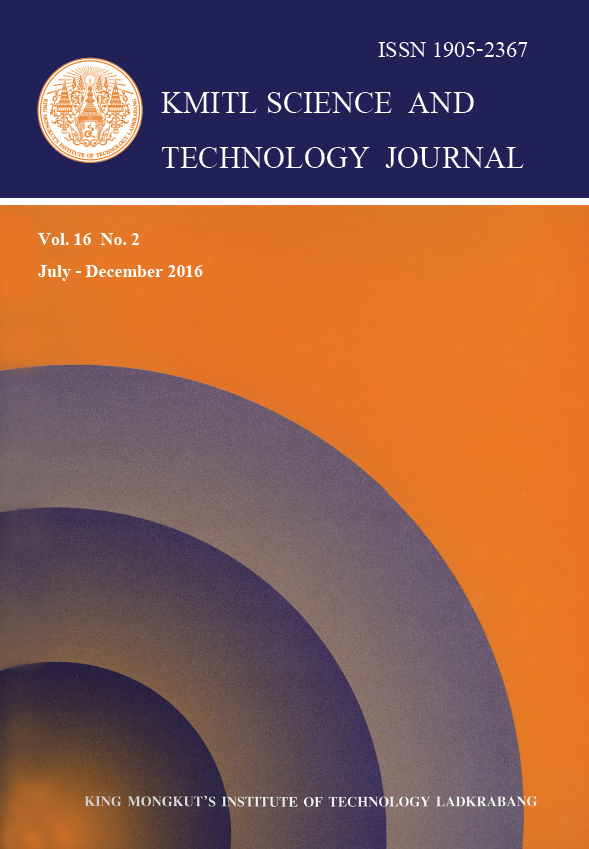Effects of Four Essential Oils on the Growth of Aflatoxin Producing Fungi
Main Article Content
Abstract
There have been records that many essential oils have shown antimicrobial properties. Some essential oils can inhibit the growth of aflatoxin producing fungi and aflatoxin production. In this study we compare the ability of 4 plant essential oils, i.e. ginger oil, anise star oil, cajuput oil and cinnamon oil for controlling aflatoxin producing fungi. The oils at concentrations of 0, 0.5, 1, 2, 3, 4 and 5% were tested against Aspergillus flavus IMI 242684 and A. parasiticus IMI 102566 on Potato Dextrose Agar (PDA). The fungi were cultured and incubated at 30o C for 7 days. The results show that anise star oil at all concentrations had the most inhibitory effect on both Aspergillus flavus IMI 242684 and A. parasiticus IMI 102566 with significant difference followed by cinnamon oil and cajuput oils. Ginger oil had the least inhibition effect.
Keywords: Essential oils, Aflatoxin, Aspergillus flavus, Aspergillus parasiticus
*Corresponding author: Tel.: +66 864476196
E-mail: kcsittic@yahoo.com
Article Details
Copyright Transfer Statement
The copyright of this article is transferred to Current Applied Science and Technology journal with effect if and when the article is accepted for publication. The copyright transfer covers the exclusive right to reproduce and distribute the article, including reprints, translations, photographic reproductions, electronic form (offline, online) or any other reproductions of similar nature.
The author warrants that this contribution is original and that he/she has full power to make this grant. The author signs for and accepts responsibility for releasing this material on behalf of any and all co-authors.
Here is the link for download: Copyright transfer form.pdf
References
[2] Mahmoud, A.-L.E., 1999. Inhibition of growth and aflatoxin biosynthesis of Aspergillus flavus by extracts of some Egyptian plants. Letters in Applied Microbiology, 29, 334-336.
[3] Thanaboripat, D., 2002. Importance of aflatoxins. KMITL Science Journal, 2(1), 3845.
[4] Masood, A., Dogra, J.V.V. and Jha, A.K., 1994. The influence of colouring and pungent agents of red chilli (Casicum annum) on growth and aflatoxin production by Aspergillus flavus. Letters in Applied Microbiology,18, 184186.
[5] Prasad, G., Sahay, S.S. and Masood, A., 1994. Inhibition in aflatoxin biosynthesis by the extract of Amorphophallus campanulatus (OL) and calcium oxalate. Letters in Applied Microbiology,18, 203-205.
[6] Thanaboripat, D., 2011. Control of aflatoxin in agricultural products using plant extracts. KMITL Science and Technology Journal, 11(1), 3542.
[7] Thanaboripat, D., Nontabenjawan, K., Leesin, K., Teerapiannont, D., Sukcharoen, O. and Ruangrattanametee, V., 1997. Inhibitory effect of garlic, clove and carrot on growth of Aspergillus flavus and aflatoxin production. Journal of Forestry Research, 8, 39-42.
[8] Thanaboripat, D., Cheunoy, W., Petcharat, U., Ruangrattanametee, V. and Krisisntu, K., 2000. Control of aflatoxigenic fungi by Thai neem. Government Pharmaceutical Organization Journal, 21, 4149.
[9] Thanaboripat, D., Monkontanawut, N., Suvathi, Y. and Ruangrattanametee, V., 2004. Inhibition of aflatoxin production and growth of Aspergillus flavus by citronella oil. KMITL Science Journal, 49(1), 1-8.
[10] Thanaboripat, D., Suvathi, Y., Srilohasin, P., Sripakdee, S., Pattanawanitchai, O. and Charoensettasilp, S., 2007. Inhibitory effect of essential oils on the growth of Aspergillus flavus. KMITL Science and Technology Journal, 6(1), 1824.
[11] Sinha, K.K., Sinha, A.K. and Prasad, G., 1993. The effect of clove and cinnamon oils on growth of and aflatoxin production by Aspergillus flavus. Letters in Applied Microbiology, 16, 114-117.
[12] Zaika, L.L. and Buchanan, R.L., 1987. Review of compounds affecting the biosynthesis or bioregulation of aflatoxins. Journal of Food Protection, 50(8), 691-708.


